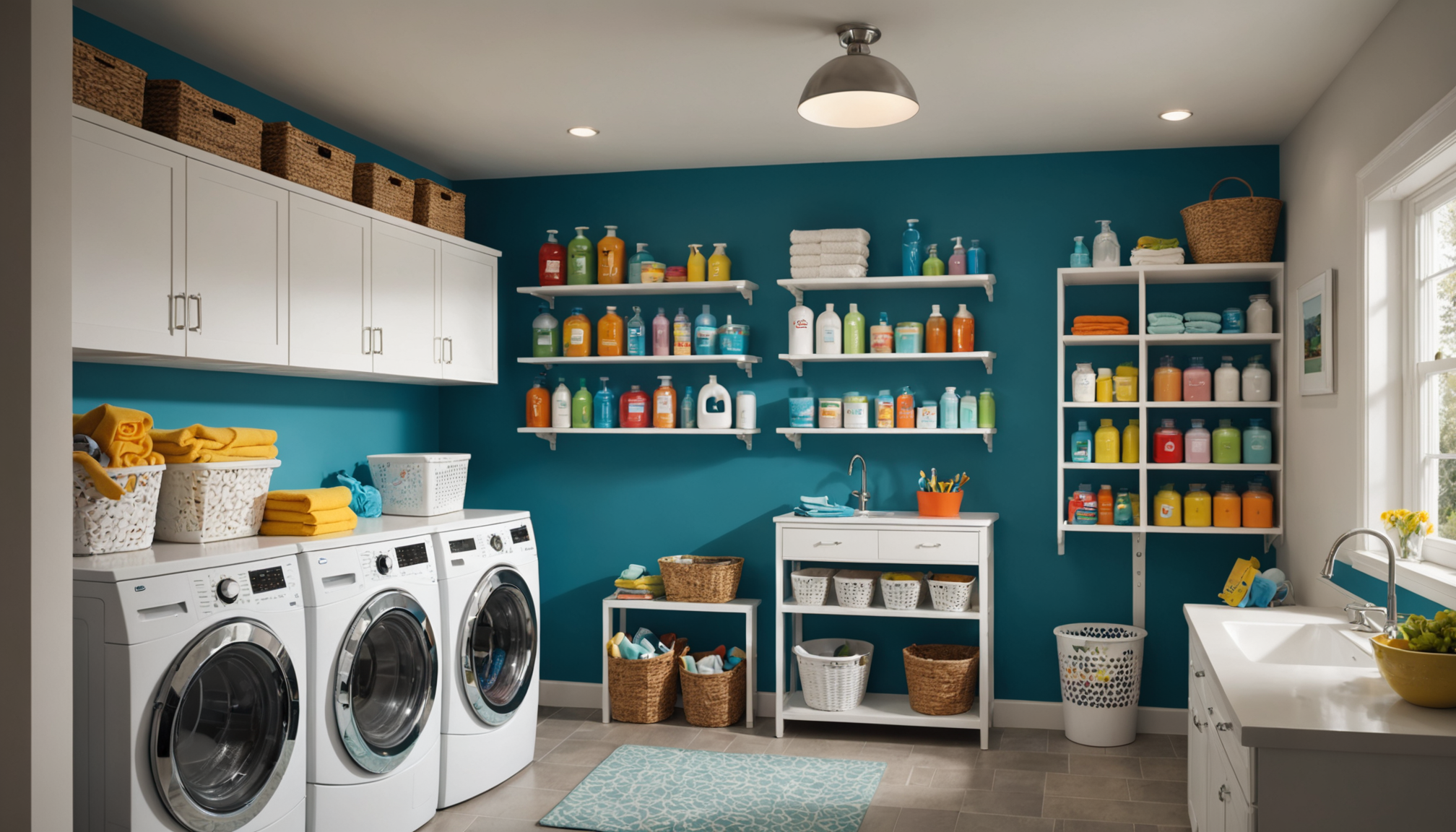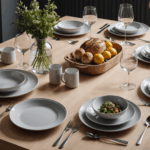Creating a laundry room that effectively utilizes space while maintaining functionality is essential for maximizing utility, especially in compact areas. A well-designed laundry room can significantly enhance the overall workflow, making laundry tasks less burdensome. The key is to implement strategic design elements that ensure every inch of space is put to its best use.
Start by evaluating the layout of your existing laundry room. Consider vertical storage solutions. Installing shelves or cabinets above your washer and dryer not only provides additional storage but also keeps essential items within arm’s reach. A set of high-quality, wall-mounted shelves can make use of vertical space without impeding the room’s functionality. Having quick access to detergents, fabric softeners, and other laundry essentials can streamline the laundry process.
Utilizing stacking washer and dryer units is another effective strategy for maximizing space. These appliances are designed to save floor area, allowing you to utilize vertical space efficiently. If a stacking unit isn’t feasible, consider sliding or stacking drawer organizers that fit under existing appliances. These drawers provide hidden storage for cleaning supplies while freeing up cabinets for other uses.
Incorporate multifunctional furniture to further enhance space utilization. An ironing board that folds out from the wall or a counter that serves as a folding station goes a long way in maximizing functionality. Another space-saving design element includes retractable drying racks or ones that can be mounted on the wall and folded away when not in use. This adapts to various needs without permanently occupying valuable room space.
| Design Element | Advantage |
| Vertical Shelving | Maximizes storage capacity; keeps items accessible |
| Stackable Appliances | Saves floor space for other uses |
| Multifunctional Furniture | Optimizes task efficiency in a compact space |
| Retractable Drying Racks | Provides flexibility for drying clothes without occupying space permanently |
Consider electrical layouts carefully. Position outlets and switches in places that support easy use of appliances, minimizing the need for cords to cross open areas, which enhances space flow and improves safety. Planning for appropriate lighting is also vital. Bright overhead lights will ensure the space is well-lit for tasks like sorting and folding, while under-cabinet lighting can provide necessary illumination for specific work areas or during nighttime hours.
Furthermore, ensure proper ventilation in your laundry design to prevent moisture build-up, which can cause damage over time and impact safety. A combination of exhaust fans and windows not only maintains air quality but also keeps mold and mildew at bay. Integrating these forms of airflow management makes the room more comfortable, especially when handling large loads.
Incorporating these space-efficient design solutions in a modern laundry room not only optimizes the available area but also improves functionality, creating a more pleasant environment to tackle household chores.
choosing the right appliances
When selecting appliances for your laundry room, it’s important to balance design, efficiency, and functionality to create a seamless and effective laundry process. Here’s how to choose the right appliances:
- Determine Your Space Constraints: Begin by measuring the available space in your laundry room. Determine if you have the room for side-by-side units or if you need to consider stackable options. Ensure there’s enough clearance for doors to open fully and for any potential required maintenance access.
- Consider Your Laundry Needs: Assess your laundry habits and needs. If you typically wash large loads, consider investing in a high-capacity washer and dryer. For smaller, more frequent loads, a compact model may suffice. This will help in choosing models that fit both your lifestyle and physical space.
- Evaluate Energy Efficiency: Look for appliances with ENERGY STAR ratings. Energy-efficient models use less electricity and water, which can lead to long-term savings on your utility bills and contribute to a more sustainable, modern home.
- Prioritize User-Friendly Features: Consider the technology integrated into the appliances. Look for features like automatic dispensers, time-remaining indicators, and programmable settings that simplify your laundry routines. Additionally, Wi-Fi-enabled models can offer remote control and notifications for added convenience.
- Plan for Proper Installation: Check the electrical and water requirements of your chosen units. Ensure your laundry room has the appropriate plumbing and electrical hookups. If not, plan for necessary upgrades to electrical outlets or plumbing to ensure safety and compliance with modern standards.
- Factor in Noise Levels: Consider the noise output of appliances, especially if the laundry room is near living areas. Opt for models designed with sound-dampening features if quiet operation is a priority, ensuring that appliance noise doesn’t disturb the household.
-
Budget and Brand Reliability: Finally, decide on a budget and research brands known for reliability and their customer service. Reading reviews and consumer reports can provide insights into the long-term durability and performance of models, helping to guide your purchase decision.
By carefully considering these factors, you can select appliances that not only fit your laundry room’s design but also enhance functionality and efficiency. This thoughtful selection process ensures that your laundry room is equipped to handle your family’s needs while maintaining a modern look and adhering to safety standards.
optimizing storage solutions
When it comes to optimizing storage solutions in your laundry room, the focus is on creating a system that not only organizes but also enhances the overall design and functionality of the space. Start by evaluating your storage needs and the types of items you regularly keep on hand. This analysis will guide you in selecting the right combination of storage elements, allowing you to keep everything from detergents to extra linens neatly arranged and easily accessible.
One key approach is to invest in customizable shelving units. These allow you to adjust shelf heights based on the items you need to store, offering flexibility and maximizing every inch of available space. For instance, taller shelves can accommodate bulk laundry detergent containers or spare baskets, while shorter shelves can be used for smaller items like stain removers and fabric softeners. These systems can also be enhanced with labeled bins or baskets, which not only ensure quick access but also maintain the room’s visual tidiness.
Another solution to consider is the incorporation of cabinetry with concealed storage options. Cabinets with pull-out drawers or bins can keep supplies hidden yet within arm’s reach, maintaining a clutter-free aesthetic and contributing to a modern laundry room design. Opt for cabinets that reach full ceiling height to optimally use vertical space, creating a sense of spaciousness and organization even in limited areas.
Additionally, don’t overlook the potential of the room’s lesser-used surfaces. The installation of hooks or rails on the backs of doors or blank walls provides additional space for hanging items like dusters, brooms, or even an extendable drying rack. This not only saves cabinet space but provides a practical spot for items that need to be readily available.
For a more seamless and integrated design, consider storage solutions that combine functionality with style. Opt for materials and finishes that complement the overall theme of your home, such as sleek metal baskets, rustic wooden crates, or chic plastic bins, allowing the storage elements to double as decorative features.
Lighting also plays a vital role in optimizing storage solutions. Incorporating lighting inside cabinets and closets ensures that every drawer and shelf is well-lit, making it easier to locate items and increasing the room’s overall functionality. Lighting fixtures that complement your storage solutions add to the harmonious flow and efficiency of your laundry tasks.
Lastly, integrating adaptable features like foldable tables or wall-mounted ironing boards ensures that spaces are multi-functional, contributing to a modern and efficient design. These elements help in reducing clutter and provide additional workspaces as needed, making any laundry chore more manageable and organized.
Incorporating strategic, effective storage solutions in your laundry room not only boosts its aesthetic appeal but also enhances its practicality. By utilizing smart design techniques and innovative storage ideas, you can create a functional, efficient, and stylish space that transforms the way you handle routine laundry tasks.
incorporating stylish decor
Incorporating a touch of style into your laundry room can transform it from just a utilitarian space into a delightful part of your home. Aesthetic design elements not only enhance the visual appeal but also contribute to a space that feels inviting and enjoyable to use. Start by choosing a color palette that complements the rest of your home. Light, airy colors or soft pastels can help small spaces appear larger, while bold, dramatic tones can add a sophisticated touch to more spacious areas.
Consider incorporating wall treatments such as textured wallpaper or bold paint to create a focal point. A feature wall with playful patterns or subtle hues can add depth and interest without overwhelming the space. Similarly, selecting the right flooring can have a significant impact. Durable materials that mimic the look of natural stone or wood add warmth and elegance, all while standing up to the wear and tear of a busy laundry room.
When decorating, don’t shy away from artwork or decorative accents. Framed prints, vintage signage, or even a curated collection of baskets can inject personality and charm into your design. Select decor elements that reflect your personal style, ensuring that the room feels like a natural extension of your home rather than an isolated workspace.
Lighting is another powerful tool for enhancing the aesthetic of your laundry room. Opt for stylish fixtures such as pendant lights, wall sconces, or even whimsical chandeliers that align with the room’s decor theme. Ample lighting not only improves visibility and safety for tasks but also helps create a warm and welcoming atmosphere.
Functional decor should not be overlooked. Choose storage solutions that match your design vision. For example, open shelves with decorative bins can provide texture and interest while displaying colorful detergent boxes or neatly folded towels. Cabinets with glass door inserts offer a sleek way to showcase supplies while keeping them readily accessible.
To complete the space, consider small details that tie the room together. Coordinated laundry hampers or baskets, chic jar containers for laundry essentials, and stylish hooks for hanging items add polished finishing touches. Detail-oriented design choices, like matching hardware or complementary fabric patterns, create a cohesive look that elevates the entire room.
Incorporating stylish decor into your laundry room is all about marrying practicality with aesthetics to create a cozy, modern space that complements your lifestyle. By integrating visual appeal with functionality, not only does the space become more enjoyable to use, but it also reflects a mindful approach to design that resonates throughout your home.
enhancing functionality and workflow
To significantly boost the functionality and workflow of your laundry room, it’s crucial to create a layout that allows tasks to be performed with ease and efficiency. Begin by analyzing how you move through the space during your laundry tasks and identify any bottlenecks or areas where the workflow can be improved. This often means arranging the appliances and work surfaces to facilitate a logical, streamlined flow from dirty to clean clothes.
Consider the work triangle concept, commonly used in kitchen design, where appliances are placed in a geometric shape that reduces movement and increases efficiency. In a laundry room setup, positioning the washer, dryer, and folding area in a triangular pattern can help minimize unnecessary steps and streamline the process, ensuring every task is seamlessly connected.
Integrate multifunctional surfaces to enhance functionality. Installing a countertop over front-loading machines provides a convenient space for folding clothes straight out of the dryer. Materials like quartz or stainless steel work well as they are durable and easy to clean. Including a built-in laundry sorter beneath this surface allows you to quickly categorize clothes by color or fabric type as you unload them, which can save time and effort.
Don’t overlook the importance of an organized workflow by incorporating modern technologies. High-tech touchpoints can include water-saving washers, steam dryers with auto-refresh cycles, and smart fabric sensors, all designed to optimize both energy use and laundry quality. Such devices not only contribute to a more streamlined process but also support sustainability and safety by minimizing water usage and detergent waste.
Ensure the layout supports ergonomic practices. Place frequently-used items, such as detergent and fabric softeners, at arm’s reach to prevent strain from unnecessary bending or reaching. Consider height-adjustable shelving or foldable tables that can be tailored to different activities and user needs.
For a truly safe and efficient space, proper electrical planning cannot be overstressed. Position electrical outlets thoughtfully to eliminate cord tangles and enhance overall safety, particularly around water sources. This might involve installing GFCI outlets to prevent electrical shocks in moist environments. Well-placed electrical setups, combined with strategically planned lighting, maintain a bright, hazard-free laundry room.
In a modern laundry room, workflow and functionality are maximized by implementing thoughtful design choices that accommodate daily routines while fostering a safe environment. When the functional layout supports the tasks at hand, the laundry room transforms from a basic utility area into an efficient, enjoyable, and safe workspace.
In conclusion, creating a well-designed laundry room involves a balance of efficiency, style, and functionality. By maximizing space, selecting functional appliances, optimizing storage, incorporating decor, and focusing on workflow, you establish a space that makes laundry an enjoyable and seamless chore. Thoughtful design transforms a utilitarian space into an essential part of your home, enhancing daily routines and supporting a modern lifestyle.


